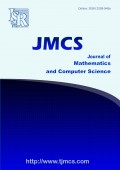A New and Quick Method to Detect Dos Attacks by Neural Networks
-
3919
Downloads
-
4357
Views
Authors
Mohammad Masoud Javidi
- Department of Computer Science, Shahid Bahonar University of Kerman, Kerman, Iran.
M. Hassan Mohammad Hassan
- Department of Computer Science, Shahid Bahonar University of Kerman, Kerman, Iran.
Abstract
Since it is technically impossible to create computer systems (Hardware and Software) without any defect or security failure, intrusion detection in computer systems’ researches is specifically regarded as important.IDS is a protective system that can detect disorders occurring on the network. The procedure goes as intrusion detection can report and control occurred disorders through steps including collecting data, seeking ports, controlling computers, and finally hacking. So, intrusion detection can report control intrusion sabotage that composed of phases collecting data, probing port, gaining computer’s control and finally hacking. In this paper, we consider some different agents, each of which can detect one or two DOS attacks. These agents interact in a way not to interfere each other. Parallelization Technology is used to increase system speed. Since the designed agents act separately and the result of each agent has no impact on the others, you can run each system on discrete CPUs (depending on how many CPUs are used in IDS computers) to speed up the performance.
Share and Cite
ISRP Style
Mohammad Masoud Javidi, M. Hassan Mohammad Hassan, A New and Quick Method to Detect Dos Attacks by Neural Networks, Journal of Mathematics and Computer Science, 6 (2013), no. 2, 85-96
AMA Style
Javidi Mohammad Masoud, Mohammad Hassan M. Hassan, A New and Quick Method to Detect Dos Attacks by Neural Networks. J Math Comput SCI-JM. (2013); 6(2):85-96
Chicago/Turabian Style
Javidi, Mohammad Masoud, Mohammad Hassan, M. Hassan. "A New and Quick Method to Detect Dos Attacks by Neural Networks." Journal of Mathematics and Computer Science, 6, no. 2 (2013): 85-96
Keywords
- Multi-Layer Protection (MLP)
- Neural Network
- Intrusion Detection System
- Misuse-based IDS.
MSC
References
-
[1]
S. A. Hofmeyr, S. Forrest, A. Somayaji, , J. Computer Security - JCS, 6(3) (1998), 151
-
[2]
E. Lundin, E. Jonsson, , J. Computer Networks, 3(4) (2000), 623
-
[3]
X. D. HoanHug, P. Bertok, A multi-layer model for anomaly intrusion detection using program sequences of system calls, Proceeding of the IEEE International Conference on Networks (ICON), (2003), 531-536
-
[4]
G. Wang, J. Hao, J. Ma, L. Huang, , J.Expert Systems with Applications, 37(9) (2010), 6225
-
[5]
G. Vasiliadis, M. Polychronakis, S. Ioannidis, MIDeA: a multi-parallel intrusion detection architecture, Proceeding of the 18th ACM conference on Computer and Communications Security ;New York., (2011), 297-308
-
[6]
, , http://nsl.cs.unb.ca/NSL-KDD. , ()
-
[7]
S. P. Shieh, V. D. Gligor, , J. IEEE Trans. on Knowledge and Data Engineering, 9(4) (1997), 661
-
[8]
J. Cannady, Artificial neural networks for misuse detection, Proceedings of the 21st National Information Systems Security Conference, Berlin, (1998), 368–381.
-
[9]
A. Fakharzadeh, Z. Alamdar, M. Hosseinipour, , J. Math. Computer Sci., 5(3) (2012), 160
-
[10]
D. Bolzoni, S. Etalle, P. Hartel, POSEIDON: A 2-tier anomaly based network intrusion detection system, Proceeding of the 4th IEEE International Workshop on Information Assurance, (2006), 156-166.
-
[11]
H. Demuth, M. Beale, Neural Network Toolbox User's Guide for use with MATLAB, TheMathWorks Inc. , (2011)
-
[12]
M. Kuchaki Rafsanjani, Z. Asghari Varzaneh, N. EmamiChukanlo, , J. Math.Computer Sci., 229 (2012), 5(3)
-
[13]
J. Ryan, M. J. Lin, R. Miikkulainen, , J. Neural Information Processing Systems, 10 (1998), 943
-
[14]
W. Luo, X. Wang , A novel fast negative selection algorithm enhanced by state graphs, in: L.N. de Castro, F.J.Z.H. Knidel (Eds.), Artificial Immune Systems, vol. 4628 of Lecture Notes in Computer Science, Springer, Berlin/Heidelberg, Verlag Berlin, (2007), 168–181
-
[15]
S. H. Abulhaiba, S. A. Mahmood, R. J. Green, , IEEE Trans.on PAMI, 16(6) (1994), 664
-
[16]
M. Ostaszewski, F. Seredynski, P. Bouvry, Immune anomaly detection enhanced with evolutionary paradigms, Proceedings of the ACM Genetic and Evolutionary Computation Conference (GECCO’06), Seattle, WA, USA ; Seattle, Washington, USA. , (2006), 119–126
-
[17]
S. X. Wu, W. Banzhaf, , , 1 (2010), 10(1)
-
[18]
D. Parikh, T. Chen, , J. IEEE Transactions on Information Forensics and Security, 3(6) (2008), 381
-
[19]
The KDD99 Dataset, , http://kdd.ics.uci.edu/databases/kddcup99/task.html. , ()
-
[20]
D. Gavrilis, E. Dermatas, Real time detection of distributeddenial-of-service attacks using RBF networks and statistical features, J.Computer Networks, 48, 5 (2005), 235
-
[21]
Hoai-Vu Nguyen, Yongsun Choi, , J. International Journal of ComputerSystem Science and Engineering, (2008), 247
-
[22]
R. Jalili, F. Imani–mehr, M. Amini, H. R. Shahriari , , J. Lecture Notes in Computer Science(LNCS), 3439 (2005), 192
-
[23]
S. Seufert, D. O. Brein, Machine Learning for Automatic Defenseagainst Distributed Denial of Service Attacks, IEEEInternational Conference (ICC) ; Dublin City Univ., Dublin, (2007), 1217–1222
-
[24]
Z. Jing-jing, H. Xiao-hong, S. Qiong, M. A. Yan, , J. China Universities of Posts and Telecommunications, 15 (2008), 68

